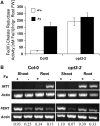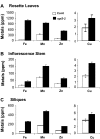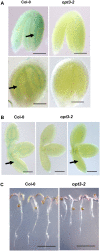The Arabidopsis AtOPT3 protein functions in metal homeostasis and movement of iron to developing seeds
- PMID: 18083798
- PMCID: PMC2245856
- DOI: 10.1104/pp.107.108183
The Arabidopsis AtOPT3 protein functions in metal homeostasis and movement of iron to developing seeds
Abstract
The Arabidopsis thaliana AtOPT3 belongs to the oligopeptide transporter (OPT) family, a relatively poorly characterized family of peptide/modified peptide transporters found in archebacteria, bacteria, fungi, and plants. A null mutation in AtOPT3 resulted in embryo lethality, indicating an essential role for AtOPT3 in embryo development. In this article, we report on the isolation and phenotypic characterization of a second AtOPT3 mutant line, opt3-2, harboring a T-DNA insertion in the 5' untranslated region of AtOPT3. The T-DNA insertion in the AtOPT3 promoter resulted in reduced but sufficient AtOPT3 expression to allow embryo formation in opt3-2 homozygous seeds. Phenotypic analyses of opt3-2 plants revealed three interesting loss-of-function phenotypes associated with iron metabolism. First, reduced AtOPT3 expression in opt3-2 plants resulted in the constitutive expression of root iron deficiency responses regardless of exogenous iron supply. Second, deregulation of root iron uptake processes in opt3-2 roots resulted in the accumulation of very high levels of iron in opt3-2 tissues. Hyperaccumulation of iron in opt3-2 resulted in the formation of brown necrotic areas in opt3-2 leaves and was more pronounced during the seed-filling stage. Third, reduced AtOPT3 expression resulted in decreased accumulation of iron in opt3-2 seeds. The reduced accumulation of iron in opt3-2 seeds is especially noteworthy considering the excessively high levels of accumulated iron in other opt3-2 tissues. AtOPT3, therefore, plays a critical role in two important aspects of iron metabolism, namely, maintenance of whole-plant iron homeostasis and iron nutrition of developing seeds.
Figures










Similar articles
-
AtOPT3, a member of the oligopeptide transporter family, is essential for embryo development in Arabidopsis.Plant Cell. 2002 Nov;14(11):2799-811. doi: 10.1105/tpc.005629. Plant Cell. 2002. PMID: 12417702 Free PMC article.
-
OPT3 is a component of the iron-signaling network between leaves and roots and misregulation of OPT3 leads to an over-accumulation of cadmium in seeds.Mol Plant. 2014 Sep;7(9):1455-1469. doi: 10.1093/mp/ssu067. Epub 2014 May 31. Mol Plant. 2014. PMID: 24880337 Free PMC article.
-
Loss of OPT3 function decreases phloem copper levels and impairs crosstalk between copper and iron homeostasis and shoot-to-root signaling in Arabidopsis thaliana.Plant Cell. 2023 May 29;35(6):2157-2185. doi: 10.1093/plcell/koad053. Plant Cell. 2023. PMID: 36814393 Free PMC article.
-
Birth, life and death of the Arabidopsis IRT1 iron transporter: the role of close friends and foes.Planta. 2022 Nov 11;256(6):112. doi: 10.1007/s00425-022-04018-7. Planta. 2022. PMID: 36367624 Review.
-
Epigenetic regulation of iron homeostasis in Arabidopsis.Plant Signal Behav. 2015;10(12):e1064574. doi: 10.1080/15592324.2015.1064574. Plant Signal Behav. 2015. PMID: 26313698 Free PMC article. Review.
Cited by
-
Iron incorporation both intra- and extra-cellularly improves the yield and saccharification of switchgrass (Panicum virgatum L.) biomass.Biotechnol Biofuels. 2021 Mar 4;14(1):55. doi: 10.1186/s13068-021-01891-4. Biotechnol Biofuels. 2021. PMID: 33663584 Free PMC article.
-
The Conservation of VIT1-Dependent Iron Distribution in Seeds.Front Plant Sci. 2019 Jul 12;10:907. doi: 10.3389/fpls.2019.00907. eCollection 2019. Front Plant Sci. 2019. PMID: 31354774 Free PMC article.
-
Rhizobacteria-Mediated Activation of the Fe Deficiency Response in Arabidopsis Roots: Impact on Fe Status and Signaling.Front Plant Sci. 2019 Jul 12;10:909. doi: 10.3389/fpls.2019.00909. eCollection 2019. Front Plant Sci. 2019. PMID: 31354776 Free PMC article.
-
The receptor kinase SRF3 coordinates iron-level and flagellin dependent defense and growth responses in plants.Nat Commun. 2022 Aug 1;13(1):4445. doi: 10.1038/s41467-022-32167-6. Nat Commun. 2022. PMID: 35915109 Free PMC article.
-
Endophytic Fungus Phomopsis liquidambaris Enhances Fe Absorption in Peanuts by Reducing Hydrogen Peroxide.Front Plant Sci. 2022 Apr 29;13:872242. doi: 10.3389/fpls.2022.872242. eCollection 2022. Front Plant Sci. 2022. PMID: 35574149 Free PMC article.
References
-
- Alonso JM, Stepanova AN, Leisse TJ, Kim CJ, Chen H, Shinn P, Stevenson DK, Zimmerman J, Barajas P, Cheuk R, et al (2003) Genome-wide insertional mutagenesis of Arabidopsis thaliana. Science 301 653–657 - PubMed
-
- Bashir K, Inoue H, Nagasaka S, Takahashi M, Nakanishi H, Mori S, Nishizawa NK (2006) Cloning and characterization of deoxymugineic acid synthase genes from graminaceous plants. J Biol Chem 281 32395–32402 - PubMed
-
- Bechtold N, Pelletier G (1998) In planta Agrobacterium-mediated transformation of adult Arabidopsis thaliana plants by vacuum infiltration. Methods Mol Biol 82 259–266 - PubMed
-
- Bellaoui M, Keddie JS, Gruissem W (2003) DCL is a plant-specific protein required for plastid ribosomal RNA processing and embryo development. Plant Mol Biol 53 531–543 - PubMed
-
- Bourbouloux A, Shahi P, Chakladar A, Delrot S, Bachhawat AK (2000) Hgt1p, a high affinity glutathione transporter from the yeast Saccharomyces cerevisiae. J Biol Chem 275 13259–13265 - PubMed
Publication types
MeSH terms
Substances
LinkOut - more resources
Full Text Sources
Medical
Molecular Biology Databases

